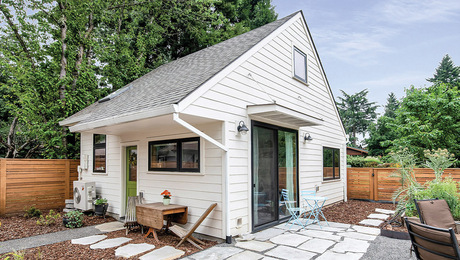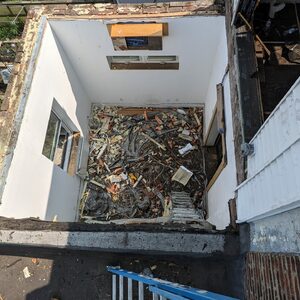Hello all. Long time reader, first time posting. Thank you all for the generosity of information I have learned here.
So the dilemma I’m having is my main bathroom remodel. My three kids like to pretend its a sauna and take 25 minute showers in a row until the giant mirror has water running down it and it looks like its raining. Not so cool for mold growth and material longevity.
Question is Can I put plywood or similar on the ceiling behind the drywall when reconstructing? Could this lead to more issues? Is my thought process backwards? I would like to prevent any nail pops, torn seams, or movement.
The house is built 1984. Two story colonial. 24inch on center Truss roof. Roof is baffled with R60 blown in insulation. I have 21 inches of insulation on the bathroom ceiling and want to improve the longevity or ease of future remodels by not having to remove the insulation to replace a ceiling.
Thanks in advance.
Discussion Forum
Discussion Forum
Up Next
Video Shorts
Featured Story

Key proposals for the next edition of the International Residential Code tackle room sizes, stair specs, emergency egress, and deck guards, among other requirements.
Featured Video
Video: Build a Fireplace, Brick by BrickHighlights
"I have learned so much thanks to the searchable articles on the FHB website. I can confidently say that I expect to be a life-long subscriber." - M.K.
Fine Homebuilding Magazine
- Home Group
- Antique Trader
- Arts & Crafts Homes
- Bank Note Reporter
- Cabin Life
- Cuisine at Home
- Fine Gardening
- Fine Woodworking
- Green Building Advisor
- Garden Gate
- Horticulture
- Keep Craft Alive
- Log Home Living
- Military Trader/Vehicles
- Numismatic News
- Numismaster
- Old Cars Weekly
- Old House Journal
- Period Homes
- Popular Woodworking
- Script
- ShopNotes
- Sports Collectors Digest
- Threads
- Timber Home Living
- Traditional Building
- Woodsmith
- World Coin News
- Writer's Digest


















Replies
Is there an exhaust fan in this bath?
How is it switched?
A timer with extended run time that works after lights out could help.
Not letting them do anything on their iPad or phone for 10 days for each offense might work.
Thanks Calvin. Constant pressure and coaching helps! lol. Room in exhausted with properly sized fan. No time but the rule is leave it on until the mirror is clear.
You probably succeeded long ago when you harped on them to lturn out the lights when you’re not in the room”.
A timer switch on the light / exhaust fan will help, especially if set for an hour.
And, I’ll assume you’ll be changing out the exhaust fan during your remodel. Make sure it’s properly installed and exhaust to the outside. Long runs should be avoided and insulated pipe helps.
The entire bathroom absent the shower area should be drywalled with moisture/mold proofed drywall product, i.e. green board or blue board, fiberglass tape and a mold-resistant joint compound. Use drywall screws only, no drywall nails. Shower areas should have cement board or "backer board" applied prior to tiling or other surface application. These two steps will prevent moisture damage from the circumstances described. There is no need to add a plywood substrate. It will provide no protective effect.
Just as importantly, the bathroom needs a proper size exhaust fan capable of rapidly removing steam to reduce condensation on surfaces where temperatures are cooler. Make certain that the fan is installed in the ceiling and exhausted through a vent installed at the soffit, or if in a wall then nearest the ceiling and vented through the exterior wall. Also make certain that the fan is strategically located near, but not directly at, the shower ceiling. Code prohibits direct potential access to electrical outlets or devices from any point within the shower area so take note of this fact. Also take note that all exhaust fans unavoidably condensate to some extent because of the air environment involved. Make certain that the fan has a proper reusable filter and change it as often as necessary.
Also note that if the A/C vent is blowing sufficient cold air into the bathroom while the shower is operating at the described temperatures and timeframe then it's only natural that high steam and condensation will be the result. If the time spent showering can't be reduced then close off the vent during this time and it will help cut down the condensation effect.
Thanks Joe. I will follow you input.
Excellent input thank you Joe, Calvin! I do have a properly size exhaust fan in the bathroom. It is located as described. Current house rule is leave the fan on until the mirror is free of condensation, which is followed well. I'll take consideration to the vent. Prepping for a remodel for my main bath, I'll have to remove the 20+inches of blown in insulation when in gut the room. As described I will be using moisture approved drywall, glued and screwed. But my dilemma is future proofing the remodel. My desire is to not have to remove the insulation ever again in order to replace ceiling drywall. If I hang plastic or similar, I loose the benefit of gluing the ceiling drywall. If I sheet it with OSB/plywood or similar I get all the benefits, but I don't know if it would trap vapor/moisture between the ply and drywall creating as adverse affect. Any input?
Okay, there is no benefit of using construction adhesive or other glue product in attaching your drywall to the studs and ceiling rafters. Mold-resistant 5/8" type X at your ceiling and 1/2" drywall at the walls all applied with 1-1/4 inch drywall screws 12" o.c. at the edges and in the field portion is entirely sufficient to properly secure the product. IRC states 16" o.c. but 12" is the common practice. Proper application of the fiberglass joint tape and moisture-resistant joint compound reinforces the attachment of the drywall as well. Also make certain to use backer board throughout the shower section walls as well and follow online diagrams closely regarding how low the backer board should be to the shower pan. Backer board also receives a certain type of screws, joint tape and joint compound to assure adhesion.
The key is to properly exhaust the steam from the shower as soon as possible. Exhaust fans are inexpensive so replacement is advised and make certain the CFM is above the stated SF coverage due to the special circumstances you are attempting to alleviate but not more than 50sf beyond SF rating. Otherwise, the applications as discussed will perform extremely well and provide a full product life given proper application and finishes. Make certain to use a good layer of drywall primer coat on the walls and ceiling prior to final paint that should be a gloss finish product. Never use flat finish paints in wet areas. You can also add a mold-mildew preventative to the paint that is available from your paint supplier. The entire combination should certainly give you peace of mind and a long life application.
The "glued & screwed" method is only viable in very certain instances of residential and commercial construction but has no place where drywall application itself is concerned. It will not enhance your work product.
All great info to consider. Thanks again Joe.
Thank you for sharing your situation. It sounds like your bathroom sees quite a bit of use, which can definitely lead to moisture issues. Here are some recommendations based on your concerns:
Ceiling Structure and Materials:
Plywood Backing: While you can install plywood behind the drywall, it’s not typically necessary for residential bathroom ceilings. Plywood can provide additional support, but it won't necessarily solve issues related to moisture and humidity.
Drywall Type: Use moisture-resistant drywall (often referred to as green board) or even better, cement board for the bathroom ceiling. These materials are designed to withstand high humidity and reduce the risk of mold growth.
Moisture Management:
Ventilation: Ensure you have a high-quality exhaust fan installed in the bathroom. The fan should be appropriately sized for the room (measured in CFM—cubic feet per minute) and vented to the exterior of the house. This is crucial for removing excess moisture during and after showers.
Dehumidifier: Consider adding a dehumidifier to the bathroom to help control humidity levels, especially if the bathroom is used frequently.
Insulation and Airflow:
Vapor Barrier: Ensure there is a proper vapor barrier in place between the insulation and the drywall. This will help prevent moisture from seeping into the ceiling and causing mold growth.
Air Circulation: Make sure the insulation isn’t blocking the soffit vents. Proper airflow in the attic space is essential to prevent condensation build-up.
Preventative Measures:
Regular Maintenance: Regularly check for signs of mold or mildew and address them immediately. Keep an eye on the exhaust fan and clean it periodically to ensure it’s functioning effectively.
Paint: Use a high-quality, mold-resistant paint on the bathroom ceiling. This adds an extra layer of protection against moisture.
Long-term Considerations:
Future Remodels: If you want to avoid disturbing the insulation during future remodels, consider using access panels or creating a drop ceiling that can be more easily removed and replaced.
By focusing on moisture management and using the right materials, you can significantly extend the life of your bathroom ceiling and prevent common issues like nail pops, torn seams, and mold growth.
I hope this helps! If you have any more questions or need further assistance, feel free to ask.
Great input. Thank you UR.
Remember too, the gap under your bathroom door is the only provider (or should be) of air that replaces your exhaust air.
Hardly any gap means hardly any moist air going out.
Thanks again Calvin. Door gap and HVAC register
One option for the attic insulation could be kraft-faced batt insulation or FSK. In the future you could easily relocate them out of the way to do repairs/replacement of the bathroom ceiling and place them back. In order to get the R-value, you would just need to alternate stacking the insulation 90 degrees. Only the first layer that touches the back of the drywall should be faced.
One key importance after the correct drywall, screws, tape & mud is to air seal the annular space around all penetrations: ceiling lights, receptacles, bathroom fans, wall sconces, plumbing fixtures, etc. This will provide continuity for your vapor barrier and keep the vapor in the room to be exhausted outside instead of getting into the wall cavities.
Adding plywood behind the drywall could be a smart move to prevent issues from moisture and improve durability. Just ensure it's moisture-resistant and consider ventilation for long-term maintenance.